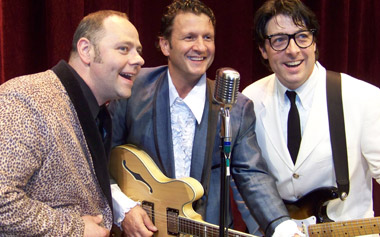It’s coincidental, but entirely appropriate, that the Theater Project opened its 15th anniversary season at the Majestic Theater last week on the day after what would have been Buddy Holly’s 75th birthday. Buddy: The Buddy Holly Story is the show that launched the theater in 1997 and has become its signature hit. The current production is its third revival here.
Holly wasn’t an Elvis or Little Richard who exuded sexual danger. He was the nearsighted boy next door who wrote infectious pop songs and sang them with a hiccup in his plain-vanilla voice. He rode the charts for only a year and a half before riding that ill-fated airplane on “the day the music died.” But in that brief period he changed rock ‘n’ roll, both musically, bridging white rockabilly and black R&B, and socially, a white kid from Texas performing in Harlem’s Apollo Theater and touring with an otherwise all-black revue.
Alan Janes’ script for Buddy is the definition of perfunctory, stitching snapshots of Holly’s career into a tapestry of 13 of his songs, from “That’ll Be the Day” and “Peggy Sue” to “Rave On” and “True Love Ways,” along with another dozen hits of the era. Buddy asserts his musical vision by blowing off a radio station’s and a record company’s insistence that he play only country; teams up with independent producer Norman Petty; meets his soon-to-be wife, Maria Elena Santiago, and proposes on the first date (fact); breaks up with his band, the Crickets, but (fiction) is back with them for the fateful final concert in February 1959.
A loose recreation of that show, occupying the last 45 minutes of this three-hour performance, includes the two other stars who perished in the plane crash, J.P. “The Big Bopper” Richardson (Tim Reilly) and Latino heartthrob Richie Valens (Frank Manzi).
Watching Danny Eaton’s lively, likeable production, it’s hard to suppress the image of those PBS pledge-drive concerts where rockers of the past trot out their hits. Several veterans of the show’s previous Majestic outings are back again, now twice the age of their characters. But Ben Ashley brings the same boyish enthusiasm to the title role as he did 15 years ago, and so do the other long-in-the-tooth performers, including two of the three Crickets, Tim Hosmer and Dan Whelton (Bill Morey is the trio’s age-appropriate member), Ray Zorin as Petty and Christopher Shanahan as the hometown DJ.
Act One closes with the legendary gig at the Apollo, where the Crickets showed up after being booked by a promoter who thought they were black. In a showcase of Valley talent, Karen Bolden-King and Moonlight Davis lay down a couple of numbers by black groups of the era, and Greg Alexander gets the audience singing Cab Calloway’s “Minnie the Moocher,” before Buddy and the boys hit the stage for their barrier-busting set.
It’s a pity the storyline doesn’t have more heft—skimming over Holly’s sometimes bruising ambition and ultimately poisonous relationship with his mentor, Petty, for instance—because the music, mostly played by the performers and guided by music director Mitch Chakour, has plenty. The music didn’t die on that snowy Midwestern night, but the meteor that was Buddy Holly imparted a lasting flavor to our American pie.
Buddy: The Buddy Holly Story: through Oct. 30, Majestic Theater, 131 Elm St., West Springfield, (413) 747-7797, majestictheater.com.



